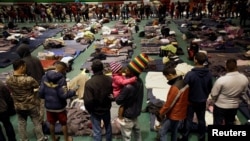The head of Mexico's immigration agency says the country has received 112 Central American migrants from the United States, including 25 minors in a policy reversal
Mexico has accepted 112 Central American migrants from the United States, and they include 25 minors in a policy reversal, the head of Mexico's immigration agency said Monday.
Late last month, the U.S. launched the so-called “remain in Mexico” program negotiated with Mexico to make some asylum applicants wait in Mexico during the months and even years that it can take to resolve such cases.
17 families from 3 countries
National Immigration Institute Commissioner Tonatiuh Guillen had said last month that Mexico wouldn't accept migrants younger than 18 while they await the resolution of their U.S. asylum claims. But Guillen said Monday that Mexico is accepting children who are accompanied by their parents, saying the numbers remain small.
Guillen said the 112 migrants sent back through Feb. 21 included 17 families from Honduras, El Salvador and Guatemala. The migrants return to Mexico through the El Chaparral crossing in Tijuana.
So far, there has been capacity to handle the returnees in Tijuana's shelters, but Guillen said that “there's a limit.”
Concerns with program
The U.S. has expressed interest in expanding the program to other ports of entry along the border, but so far it remains limited to Tijuana. Guillen believes the program's expansion would draw more legal challenges in the U.S. alleging that it violates the due process of the asylum seekers or puts them in danger.
“The paradox is that by the same amount that the returns grow, so does the possibility that this program, which is the United States', is unsuccessful — (that) the lawsuits that are already in their courts increase,” he said.
Guillen said Mexico is also taking steps to restrict the passage of large caravans of Central American migrants that drew U.S. attention last year. Central American migrants will now have to apply for Mexican humanitarian visas in their countries' capitals rather than applying once they arrive in Mexico, he said.
Since late last year, Mexico has issued more than 15,000 “visitor cards for humanitarian reasons.” Giving them to a migrant who has already entered Mexico would be a rare exception now, Guillen said.
'Regional visitor'
Those arriving at Mexico's southern border now are more likely to be eligible for “regional visitor” permits or “border worker” permits that would require the migrants to stay in southern Mexico.
“Yes, we are trying to take more control,” Guillen said. “It's not convenient for anyone to have these kinds of movements ... We're going to try to review closely the situation of each person. There are those who need humanitarian support, but there is also another group that has been very aggressive and doesn't have the expected profile of those who are asking for help.”







